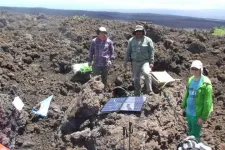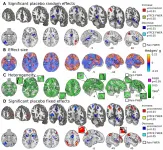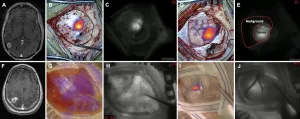(Press-News.org) A volcanic eruption in the Galápagos Islands has given scientists a fresh insight into how volcanoes behave and provided vital information that will help to predict future hazards on the islands.
Irish scientists, based at Dublin Institute for Advanced Studies (DIAS) and Trinity College Dublin respectively, were members of an international research team from Ireland, United Kingdom, United States, France and Ecuador that made the discovery.
The research published today (02.03.21) in Nature Communications reveals the first ever detailed description of a volcanic eruption from Sierra Negra - one of the world's most active volcanoes - found on Isabela Island, the largest of the Galápagos archipelago and home to nearly 2,000 people.
The new understandings developed from the research will allow Ecuadorian volcanologists to track the evolution of unrest for future eruptions in the Galápagos Islands, and communicate it to local authorities and the public.
The research process
The eruption in June 2018 began after 13 years of earthquakes and uplift of the surface marked the gradual accumulation of molten rock (magma) under the volcano. They were amongst the largest signals ever recorded before an eruption. Strong earthquakes allowed new fissures to open in the shield volcano, feeding lava flows that extended 16 km to the coast, and were active for nearly two months.
When the eruption finished, the hills within the 10 km wide caldera of the volcano were nearly two metres higher than at the start. This phenomenon, known as 'caldera resurgence', is important for understanding when and where eruptions happen, but is rare and had never been observed in such detail.
Despite their significance, the Galápagos Islands' remote location means that this is the first eruption there to have been recorded by modern monitoring instruments, including seismometers and GPS. Consequently, there have been no previous multidisciplinary studies into the volcanic processes behind Galápagos Island volcanism.
The international research team combined the latest data recorded by instruments on the ground, by satellites, and by analysis of the chemical composition of the erupted lava. They showed how ascending magma permanently uplifted a 'trapdoor' in the floor of the caldera, raising the surface, and triggering large earthquakes.
Comments from the research team
Professor Chris Bean, Head of the Geophysics Section and Director of the School of Cosmic Physics at DIAS, who was a member of the research team said:
"It was fantastic to represent DIAS on this international research team, we managed to examine the Sierra Negra volcano with an unprecedented level of detail which has produced some ground-breaking results. Although the volcano had been slowly inflating for over a decade, the final trigger to the eruption was a violent earthquake strong enough to make anything that wasn't tied down hop clear off the ground. Stress changes related to this event unzip subterranean fractures through which magma flowed to the surface in a spectacular eruption."
Dr Michael Stock, Assistant Professor of Geology at Trinity College Dublin, who was also a member of the research team, said:
"This is a genuinely multidisciplinary study which brought together a diverse team of international scientists to produce one of the most detailed records of pre-eruptive processes at an active volcano to date. The data will be invaluable in improving volcano monitoring in Galapagos, where eruptions pose a risk to the unique and fragile ecosystem. However, it also has far-reaching global implications, demonstrating that not all volcanoes are created equally - our current understanding of volcano monitoring data is largely based on well-studied eruptions in Iceland and Hawaii and may need to be urgently reassessed to effectively manage volcanic hazards in other locations."
INFORMATION:
Further information about the project is available at http://www.dias.ie/geo-recent-research-activities/ .
Hours before the 2018 eruption of Sierra Negra, the Galápagos Islands' largest volcano, an earthquake rumbled and raised the ground more than 6 feet in an instant. The event, which triggered the eruption, was captured in rare detail by an international team of scientists, who said it offers new insights into one of the world's most active volcanoes.
"The power of this study is that it's one of the first times we've been able to see a full eruptive cycle in this detail at almost any volcano," said Peter La Femina, associate professor of geosciences ...
A large proportion of the benefit that a person gets from taking a real drug or receiving a treatment to alleviate pain is due to an individual's mindset, not to the drug itself. Understanding the neural mechanisms driving this placebo effect has been a longstanding question. A meta-analysis published in Nature Communications finds that placebo treatments to reduce pain, known as placebo analgesia, reduce pain-related activity in multiple areas of the brain.
Previous studies of this kind have relied on small-scale studies, so until now, researchers did not know if the neural mechanisms underlying ...
In June 2019, an international team brought the complete skull of the 3.67-million-year-old Little Foot Australopithecus skeleton, from South Africa to the UK and achieved unprecedented imaging resolution of its bony structures and dentition in an X-ray synchrotron-based investigation at the UK's national synchrotron, Diamond Light Source. The X-ray work is highlighted in a new paper in e-Life, published today (2nd March 2021) focusing on the inner craniodental features of Little Foot. The remarkable completeness and great age of the Little Foot skeleton makes it a crucially important ...
Publishing in peer-reviewed scientific journals is crucial for the development of a researcher's career. The scientists that publish the most often in the most prestigious journals generally acquire greater renown, as well as higher responsibilities. However, a team involving two CNRS researchers* has just shown that the vast majority of scientific articles in the fields of ecology and conservation biology are authored by men working in a few Western countries. They represent 90% of the 1,051 authors that have published the most frequently in the 13 major scientific journals in the field since 1945. ...
WASHINGTON (Mar. 2, 2021) -- A report released today by the George Washington University Program on Extremism reveals new information about the 257 people charged in federal court for playing a role in the Jan. 6 attack on the United States Capitol. The report, "This is Our House!" A Preliminary Assessment of the Capitol Hill Siege Participants," also provides several recommendations aimed at combating domestic extremism.
The GW Program on Extremism tracked and categorized the people charged so far in the attack and the resulting report provides a preliminary assessment of the siege participants.
"The events of Jan. 6 may mark a watershed moment for domestic violent ...
Charlottesville, VA (March 2, 2021). Researchers in the Perelman School of Medicine at the University of Pennsylvania conducted a prospective cohort study utilizing their technique of delayed near-infrared imaging with high-dose indocyanine green (called "second window ICG" or "SWIG") in the identification of brain metastases during surgery. In this study, all metastatic lesions enhanced under near-infrared light with application of SWIG. The researchers compared near-infrared SWIG images obtained at the end of tumor resection with postoperative gadolinium-enhanced MRIs, considered the gold standard for imaging. The comparison demonstrated that SWIG can be used to predict the extent of gross-total resection and, ...
Since 1970, bird populations in North America have declined by approximately 2.9 billion birds, a loss of more than one in four birds. Factors in this decline include habitat loss and ecosystem degradation from human actions on the landscape.
At the same time, enthusiasm for bird-watching has grown, with more than 45 million recreational participants in the United States alone. Now, researchers are looking into how to mobilize these bird enthusiasts to help limit bird population declines.
Enter bird-friendly coffee.
Bird-friendly coffee is certified organic, but its impact on the environment goes further than that: it is cultivated specifically to maintain bird habitats instead of clearing vegetation that birds and other animals rely on.
Researchers ...
A new paper in Oxford Open Materials Science, published by Oxford University Press, presents low cost modifications to existing N95 masks that prolongs their effectiveness and improves their reusability post disinfectants.
The COVID-19 crisis has increased demand for respiratory masks, with various models of DIY masks becoming popular alongside the commercially available N95. The utility of such masks is primarily based on the size of aerosols that they are capable of filtering out and how long they can do so effectively.
Conventional masks like the N95 use a layered system and have an efficiency ...
Researchers at Tokyo Institute of Technology working in collaboration with colleagues at the Kanagawa Institute of Industrial Science and Technology and Nara Medical University in Japan have succeeded in preparing a material called cerium molybdate (γ-Ce2Mo3O13 or CMO), which exhibits high antiviral activity against coronavirus.
The ongoing coronavirus pandemic has highlighted the urgency not only of vaccine development and rollout but also of developing innovative materials and technologies with antiviral properties that could play a vital role in helping to contain the spread of the virus.
Conventional inorganic antimicrobial materials are often prepared with metals such as copper or photocatalysts ...
Peer Reviewed
Experimental
Animals
Consumption of a high fat diet may be activating a response in the heart that is causing destructive growth and lead to greater risk of heart attacks, according to new research.
In a paper published in Biochemical and Biophysical Research Communications, researchers looked at the effect of feeding mice a high fat diet on oxidative stress levels on heart cells. The team from the University of Reading found that cells from the mice had twice the amount of oxidative stress, and led to heart cells being up to 1.8 times bigger due to cardiac hypertrophy which is associated with heart disease.
Named first author Dr Sunbal Naureen ...





